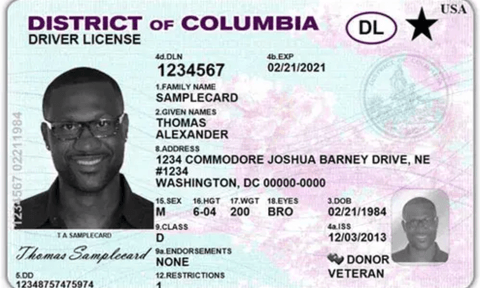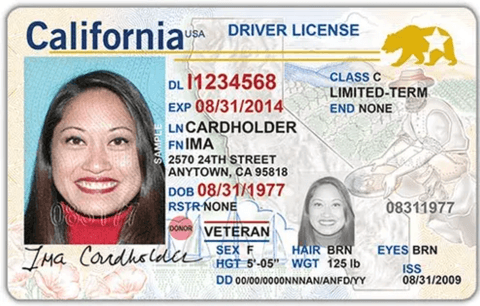Starting May 7, 2025, the driver’s license in your wallet may no longer be enough to get you through airport security and onto a plane for a domestic flight. As of that date, only licenses or state-issued ID cards that meet federal “Real ID” requirements will be accepted for boarding a flight.
You can tell whether your state ID is a Real ID by looking for a gold or black star in the upper right-hand corner. If you see the star, you’re all set.
Here are some examples of Real IDs with the star:


(Images courtesy of the U.S. State Department)
If you don’t see the star and you haven’t yet visited your state DMV to get an upgraded license, you aren’t necessarily barred from flying. There are other ID options available, including passports, military IDs and other federally issued or approved documents.
Here’s what travelers need to know about Real ID and other identification alternatives.
What is the Real ID?
Real IDs are driver’s licenses and ID cards that meet the federal government’s updated security standards. They allow individuals to board commercial flights and access secured federal facilities like military bases and federal courthouses.
Congress passed a law requiring Real IDs in 2005, but the implementation date was pushed back multiple times. Those delays are over. Effective May 7, 2025, TSA is enforcing the use of Real ID-compliant driver’s licenses and state-issued ID cards. Transportation Security Administration agents will verify IDs at airport security checkpoints.
Travelers under the age of 18 do not need a Real ID if traveling with a companion with an acceptable form of identification.
4 ID alternatives for flying if you don’t have a Real ID
Getting your Real ID can be time-consuming. It requires an in-person visit to the DMV and multiple supporting documents. If you choose not to upgrade your state driver’s license or identification card to a Real ID, or simply won’t have a Real ID ready for an upcoming domestic trip, the TSA accepts several alternatives.
1. U.S. passport or passport card
A U.S. passport is accepted as ID for boarding domestic commercial flights. A U.S. passport card, which is typically used for travel to and from Canada, Mexico, Bermuda and the Caribbean, also qualifies.
🤓Nerdy Tip
Passports (or other acceptable forms of identification) that have expired within the past 12 months will still be accepted at TSA airport checkpoints.
If you need to get a new passport, give yourself 10 weeks of lead time. According to the State Department, as of April 2025, it takes four to six weeks to process a passport application, plus up to two weeks for shipping. If you need a passport for fast-approaching travel, you can pay extra for expedited processing, which takes two to three weeks, and one- to two-day shipping.
If you need a passport for fast-approaching domestic or international travel, you can pay $60 for expedited processing and $21.36 for the 1- to 2-day return shipping.
2. Trusted Traveler Program card
Travelers who are enrolled in a Department of Homeland Security Trusted Traveler Program can use their program card as identification for domestic routes. Accepted trusted traveler program cards include Global Entry, NEXUS, SENTRI and FAST.
Note that TSA PreCheck members do not receive an ID card, so TSA PreCheck members are not exempt from showing a Real ID. Clear, a membership that lets participants verify their identity through an eye or fingerprint scan, also does not qualify as an accepted alternative to a Real ID.
Some travel credit cards can help you cover the cost of Global Entry or NEXUS applying for these trusted traveler programs by offering a statement credit for the fees.
Cards that reimburse Global Entry fees
Applying for these programs isn’t usually a fast process, though. It requires an online application and in-person appointment.
3. Foreign passport
If you have a passport from another country, it is also accepted as identification for commercial flights.
4. Specialized credentials
The TSA also accepts the following approved IDs when flying domestically:
-
U.S. military ID (including military-issued dependent IDs).
-
Tribal identification card.
-
Veteran health identification card.
-
State-issued enhanced driver’s license from Michigan, Minnesota, New York, Vermont or Washington.
-
Homeland Security Presidential Directive 12 personal identity verification card (HSPD-12 PIV).
-
Canadian driver’s license.
-
Canadian Indian and Northern Affairs card.
-
Transportation Worker Identification Credential (TWIC).
-
USCIS Employment Authorization Card (I-766).
-
Merchant Mariner Credential.
What if you don’t have a Real ID at the airport?
If you arrive at the airport without a Real ID or acceptable alternative identification, you might still be able to get through security.
A TSA officer will need to confirm your identity by asking questions, such as about your name and address. Travelers who pass this step can move on to physical screening. However, this option isn’t guaranteed. TSA recommends that if you do not have a Real ID and must undergo this alternative verification process, it’s best to have at least a three-hour cushion before your departure to go through the steps.
